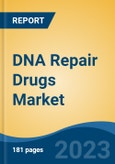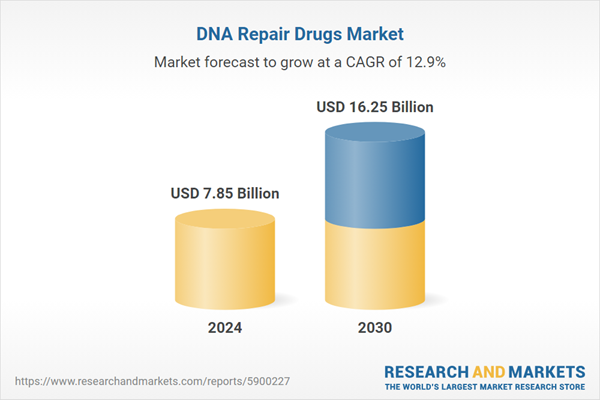Speak directly to the analyst to clarify any post sales queries you may have.
10% Free customizationThis report comes with 10% free customization, enabling you to add data that meets your specific business needs.
Key Market Drivers
Increasing Cancer Incidence
The global population is aging, and this demographic shift has a significant impact on cancer incidence. Cancer can occur at any age; however, its prevalence increases significantly with aging. In 2022, approximately 53% of diagnosed cancer cases were in individuals aged 65 and above, highlighting the strong correlation between aging populations and rising cancer incidence. With increasing age, individuals are more susceptible to genetic mutations that can lead to cancer. As the elderly population grows, so does the prevalence of cancer, creating a substantial demand for innovative treatments like DNA repair drugs.Modern lifestyles often involve exposure to numerous cancer risk factors, including poor dietary habits, sedentary lifestyles, and increased consumption of tobacco and alcohol. Research indicates that 90-95% of cancer cases can be attributed to environmental and lifestyle factors, emphasizing a significant preventable risk component. These lifestyle choices contribute to the rise in cancer cases. DNA repair drugs are seen as potential solutions to address the genetic damage caused by such risk factors.
Key Market Challenges
Complexity of DNA Repair Mechanisms
One of the primary challenges in the development of DNA repair drugs is the intricate nature of DNA repair mechanisms. DNA repair is a highly regulated and multifaceted process involving various enzymes, pathways, and checkpoints. Different types of DNA damage require specific repair mechanisms. Designing drugs that can effectively target and modulate these complex processes while minimizing off-target effects is a formidable task. Additionally, DNA repair mechanisms vary between individuals, making it challenging to create a one-size-fits-all solution. Personalized medicine approaches require tailoring treatments to an individual's genetic profile, further complicating drug development and clinical trials.Key Market Trends
Precision Medicine and Personalized Treatment
One of the most significant trends in the DNA Repair Drugs Market is the shift towards precision medicine. Advances in genomics and molecular diagnostics have enabled healthcare providers to tailor treatment plans to an individual's genetic profile. This trend recognizes that each patient's genetic makeup is unique, influencing their response to DNA repair drugs and other therapies. By identifying specific genetic mutations and DNA repair deficiencies in patients, healthcare professionals can select the most appropriate DNA repair drugs or combination therapies. This approach maximizes treatment efficacy while minimizing side effects, representing a paradigm shift in healthcare towards personalized, patient-centric treatments.Key Market Players
- GlaxoSmithKline plc
- F. Hoffmann-La Roche Ltd.
- Abbvie Inc.
- Pfizer Inc.
- Astrazeneca plc
- Sanofi S.A.
- Bayer AG
- Gilead Sciences Inc.
- Merck & Co. Inc.
- Novartis AG
Report Scope:
In this report, the Global DNA Repair Drugs Market has been segmented into the following categories, in addition to the industry trends which have also been detailed below:DNA Repair Drugs Market, By Drug Type:
- Alkylating Agents
- PARP Inhibitors
- Topoisomerase Inhibitors
- Other
DNA Repair Drugs Market, By Application:
- Neurodegenerative Diseases
- Oncological
- Cardiovascular Diseases
- Stroke
DNA Repair Drugs Market, By Distribution Channel:
- Retail Pharmacies
- Hospital Pharmacies
- Others
DNA Repair Drugs Market, By Region:
- North America
- United States
- Canada
- Mexico
- Europe
- France
- United Kingdom
- Italy
- Germany
- Spain
- Asia-Pacific
- China
- India
- Japan
- Australia
- South Korea
- South America
- Brazil
- Argentina
- Colombia
- Middle East & Africa
- South Africa
- Saudi Arabia
- UAE
Competitive Landscape
Company Profiles: Detailed analysis of the major companies present in the Global DNA Repair Drugs Market.Available Customizations:
With the given market data, the publisher offers customizations according to a company's specific needs. The following customization options are available for the report.Company Information
- Detailed analysis and profiling of additional market players (up to five).
This product will be delivered within 1-3 business days.
Table of Contents
Companies Mentioned
- GlaxoSmithKline plc
- F. Hoffmann-La Roche Ltd.
- Abbvie Inc.
- Pfizer Inc.
- Astrazeneca plc
- Sanofi S.A.
- Bayer AG
- Gilead Sciences Inc.
- Merck & Co. Inc.
- Novartis AG
Table Information
| Report Attribute | Details |
|---|---|
| No. of Pages | 180 |
| Published | March 2025 |
| Forecast Period | 2024 - 2030 |
| Estimated Market Value ( USD | $ 7.85 Billion |
| Forecasted Market Value ( USD | $ 16.25 Billion |
| Compound Annual Growth Rate | 12.8% |
| Regions Covered | Global |
| No. of Companies Mentioned | 10 |









